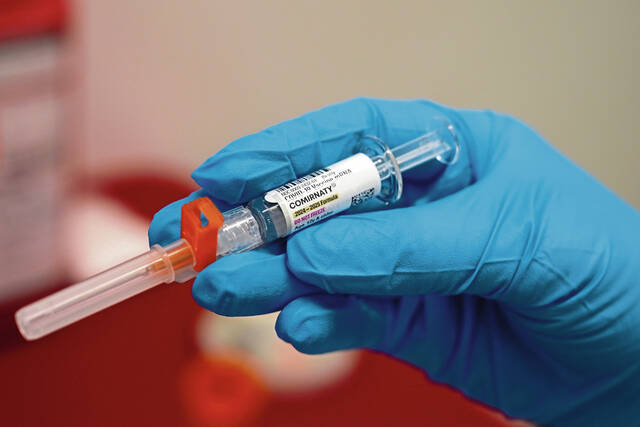https://mirror.triblive.com/local/regional/cold-flu-and-covid-post-holiday-spike-has-arrived/
Cold, flu and covid cases down from last year, but post-holiday spike has arrived

Western Pennsylvania is a little healthier than last year in terms of flu, covid-19 and respiratory virus cases.
While the overall figures are down, local health systems said doctors’ offices and hospitals are in the midst of a post-holiday spike in all three.
“We’ve definitely seen an uptick, and that’s typical for this time of year,” said Dr. Carol Fox, chief medical officer for Independence Health system. “Among the things we can readily identify, the preponderance for us is influenza. And that seems to be consistent with the region, as well.”
Data from the Allegheny County Health Department shows reports of all three illnesses are down significantly from the same timeframe in the 2023-24 season. Health officials noted, however, that the peak of last year’s cold-and-flu (and now covid) season already had come and gone by late January.
Dr. Amy Crawford-Faucher, a family physician who leads Allegheny Health Network’s Primary Care Institute, said AHN has seen a bump in office visits and hospitalizations for covid, flu and respiratory syncytial virus (RSV), the most common cause of lower respiratory tract infections.
“Right now, it’s about even between covid and flu admissions,” she said. “Where we’ve really seen a difference is in our virtual urgent care. We took care of about 2,900 people through virtual care in the past month, and the majority have been respiratory complaints. That has been much busier than in the fall.”
UPMC Chief Medical Officer Dr. Don Yealy said UPMC’s staff has seen far fewer flu cases so far this season than in 2023-24.
“There were about 13,000 last season to this point, and this season we’ve seen about half that,” Yealy said.
Early January is generally when seasonal infectious disease case numbers peak and begin to slope back downward. Yealy said the 2023-24 cold and flu season began and ended earlier, which could partially account for the higher figures.
“We’re not through the season yet,” he said. “This year, the numbers aren’t trivial, but it’s beginning to look more like the common flu season, both in the peak volume and the timing.”
Independence’s covid numbers in particular have tailed off since 2022, Fox said.
“When the pandemic began, we saw a lot of cases at the end of 2020 and the start of 2021,” she said. “The cases have declined pretty steadily since then, and the numbers have been fairly flat recently.”
Crawford-Faucher said part of that decline can be attributed to an increase in at-home testing.
“In the first half of the pandemic, all testing happened at medical facilities and we had a much better idea of the total cases,” she said. “What we have better data on now is hospitalization cases. Covid isn’t completely seasonal the way flu is, but we certainly saw a big spike in respiratory illnesses about a year ago this time, and I think that reflects the combination of the respiratory illness season and the holidays when people are together.”
Crawford-Faucher said AHN also saw a bump in covid cases in September, shortly after children returned for the 2024-25 school year.
“And that was a bump in both kids and parents,” she said.
Yealy said UPMC’s covid case numbers have risen since mid-November, but he noted covid does not have the same type of direct seasonality as influenza and respiratory viruses. He also cautioned any figures from local health systems are only a slice of the overall pie.
“People can test at home, people recover at home and certainly not every cold, flu or covid case ends up requiring a doctor’s visit or a hospital stay,” he said. “Our figures are a fraction of what’s happening in the community.”
Health systems are also on the lookout for norovirus, better known as the stomach flu, a highly contagious virus which causes vomiting and diarrhea. The Centers for Disease Control and Prevention tracks norovirus outbreaks across the nation and said, between Aug. 1 and Dec. 11, 2024, there were 495 norovirus outbreaks, compared a 363 during the same time period in 2023.
“We have seen an increasing number of patients with gastrointestinal symptoms consistent with norovirus infection,” Fox said. “Good hand washing is essential in limiting transmission. If you are living with someone with vomiting or diarrhea, it is also important to clean high-touch surfaces frequently.”
Pennsylvania is not one of the 15 states that supplies data for the CDC’s NoroSTAT Network, which tracks the outbreaks.
And, while covid is not the same international menace that reared its head in 2020 and 2021, thanks to things such as natural immunity, widespread vaccination and increased hygiene, physicians advised people to always keep a close eye on their symptoms if they do feel ill.
“If you’re having difficulty breathing or you feel like you can’t catch your breath, you should definitely seek care,” Fox said. “If you notice your lips or fingertips getting pale or blue, those are things which demonstrate you’re not getting adequate oxygen. And for those with chronic conditions, you’d want to check with your physician to see if you should consider using an antiviral to avoid more serious problems.”
The winter illness season tends to peak between December and February, according to the Centers for Disease Control and Prevention.
Copyright ©2025— Trib Total Media, LLC (TribLIVE.com)
